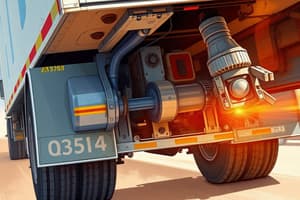Podcast
Questions and Answers
What is the primary purpose of safety chains when hooking up a trailer?
What is the primary purpose of safety chains when hooking up a trailer?
- To prevent the trailer from detaching if the hitch fails (correct)
- To connect the trailer light to the truck
- To ensure proper weight distribution on the hitch
- To stabilize the trailer during transport
Which adjustment is required for the trailer hitch ball in relation to the trailer coupler?
Which adjustment is required for the trailer hitch ball in relation to the trailer coupler?
- The hitch ball should be removed for adjustment.
- The hitch ball and coupler must be at the same height.
- The hitch ball should be slightly lower than the coupler. (correct)
- The hitch ball should be higher than the coupler.
What should you do with the trailer jack after connecting the trailer to the hitch?
What should you do with the trailer jack after connecting the trailer to the hitch?
- Keep it at a 45-degree angle to stabilize the trailer.
- Leave it extended to provide additional support.
- Raise it so that it is parallel to the neck of the trailer. (correct)
- Remove it completely from the trailer.
How can you ensure proper alignment when reversing the truck to hook up the trailer?
How can you ensure proper alignment when reversing the truck to hook up the trailer?
What is the first step you should take before hooking up a trailer?
What is the first step you should take before hooking up a trailer?
What is one function of safety chains when towing a trailer?
What is one function of safety chains when towing a trailer?
Which of the following is a requirement for safety chains according to towing regulations?
Which of the following is a requirement for safety chains according to towing regulations?
What should be checked during the double-check step before towing?
What should be checked during the double-check step before towing?
What can result from improper hitching of a trailer?
What can result from improper hitching of a trailer?
What is essential regarding the weight distribution of cargo on a trailer?
What is essential regarding the weight distribution of cargo on a trailer?
Flashcards are hidden until you start studying
Study Notes
Equipment Preparation
- Gather necessary items: trailer hitch, safety chains, trailer light connection, and specific accessories for the trailer.
- Ensure the trailer hitch is properly sized for your vehicle.
Towing Capacity
- Refer to your truck’s owner manual for its towing capacity.
- Avoid exceeding this limit to prevent accidents and vehicle damage.
Positioning
- Park the truck on level ground, directly in front of the trailer, ensuring ample space for maneuvering.
Trailer Adjustment
- Ensure the trailer hitch ball is slightly lower than the trailer coupler height.
- Adjust the coupler height using a hand crank if necessary and ensure the coupler is unlocked.
Hitch Ball Connection
- Reverse the truck, aligning the trailer coupler over the hitch ball.
- Use an additional person for guidance to ensure correct positioning.
- Lower the coupler onto the ball, lock it, and insert safety pins.
Jack Securement
- Raise the small wheel of the jack completely after connecting the trailer.
- Align the jack parallel to the trailer neck; remove or insert safety pins if required.
Safety Chains Attachments
- Cross safety chains under the trailer coupler for an “X” pattern.
- Connect chains to the truck's hitch anchor points without excessive slack or tightness.
- Ensure chains do not touch the ground and are capable of supporting the trailer’s weight.
Light Connection
- Plug the trailer’s electrical connection into the truck’s outlet.
- Securely insert the plug and test the trailer lights, including brake lights and turn signals.
Cargo Security
- Confirm that cargo is secured and evenly distributed to prevent shifting while driving.
Final Check
- Inspect the trailer and truck for loose connections, low tire pressure, and damage.
- Verify that the trailer tags are current.
Safety Chain Specifications
- Chains should have a minimum diameter of ¼ inch.
- Must support the gross weight of the towing capacity; each chain's strength should exceed the load weight.
- Designed to prevent the coupler from touching the ground if the trailer disconnects, while allowing slack for turns.
Importance of Proper Hitching
- Safety chains act as a backup to prevent trailer separation from the towing vehicle, crucial for accident prevention.
- South Carolina law requires robust safety chains to secure trailers during towing.
- Proper attachment increases stability and reduces trailer sway during maneuvers.
Consequences of Improper Hitching
- Leading cause of traffic accidents, potentially resulting in injuries and fatalities.
- Annually, hundreds die and thousands are injured due to hitching failures.
- Financial losses can result in hefty repairs and potential job loss due to accidents caused by improper trailer connections.
Studying That Suits You
Use AI to generate personalized quizzes and flashcards to suit your learning preferences.




